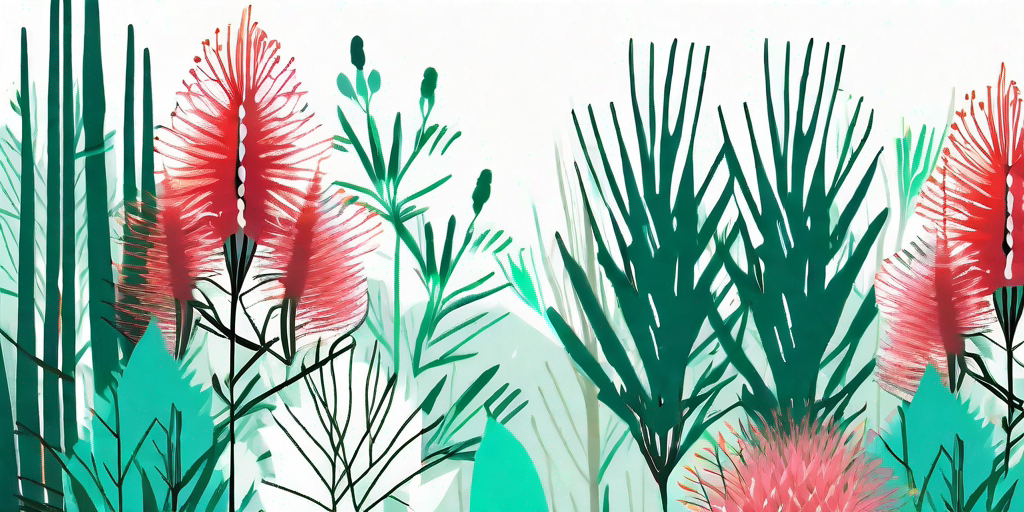
Ah, the bottlebrush plant, or to use its Sunday name, Callistemon. This Australian native has been adding a splash of colour to gardens around the world for centuries. With its vibrant red, pink, or yellow flowers that resemble a bottlebrush, it's no wonder this plant is a favourite among garden enthusiasts. But how do you cultivate this beauty in your own garden? Let's dive in, shall we?
Understanding the Bottlebrush Plant
Before we get our hands dirty, let's take a moment to appreciate this botanical wonder. The bottlebrush plant belongs to the Myrtaceae family, which also includes eucalyptus and guava. It's a hardy little fellow, able to withstand drought, frost, and even salty sea breezes. But it's the plant's unique, brush-like flowers that truly steal the show.
These flowers are made up of multiple stamens, with no petals to speak of. Instead, the stamens are coloured, creating the illusion of a brush dipped in vibrant paint. Depending on the species, you could have a bottlebrush plant that blooms in spring, summer, or even year-round. Now that's what we call a showstopper!
Types of Bottlebrush Plants
There are around 50 species of bottlebrush plants, each with its own unique charm. Some of the most popular include the C. citrinus, or lemon bottlebrush, which boasts bright red flowers and a lemony scent. Then there's the C. viminalis, or weeping bottlebrush, with its drooping branches and crimson blooms. And let's not forget the C. speciosus, or Albany bottlebrush, which is known for its large, brilliant red flowers.
But don't feel limited to these choices. With so many species to choose from, you're sure to find a bottlebrush plant that tickles your fancy.
Planting and Caring for Your Bottlebrush
Now that we're acquainted with our star, let's get down to business. Planting and caring for a bottlebrush plant isn't rocket science, but it does require a bit of know-how.
First things first, bottlebrush plants love the sun. So, choose a spot in your garden that gets plenty of sunlight. They also prefer well-drained soil, so avoid areas where water tends to pool. As for when to plant, spring is the ideal time, as this gives the plant ample time to establish itself before winter.
Watering and Fertilizing
When it comes to watering, less is more. Bottlebrush plants are drought-tolerant, so they don't need a lot of water. A deep watering once a week should suffice. However, during particularly hot and dry periods, you might need to water more frequently.
As for fertilizing, a slow-release fertilizer applied in spring and again in fall should do the trick. This will provide your plant with the nutrients it needs to produce those stunning flowers.
Pruning and Propagating
Pruning is key to maintaining a healthy and attractive bottlebrush plant. The best time to prune is after flowering, as this encourages new growth and more flowers the following season. Just be sure to use sharp, clean pruning shears to avoid damaging the plant.
If you want to propagate your bottlebrush plant, you can do so by taking cuttings. Simply cut a healthy branch, dip the cut end in rooting hormone, and plant it in a pot filled with soil. With a bit of patience and care, you'll have a new bottlebrush plant in no time.
Common Problems and Solutions
Like any plant, the bottlebrush can encounter a few problems. But don't fret, most of these issues are easily resolved.
One common problem is leaf drop, which can be caused by overwatering, poor drainage, or a lack of sunlight. If your plant is dropping leaves, check its environment and make the necessary adjustments.
Pests and Diseases
Bottlebrush plants are generally pest-resistant, but they can occasionally be bothered by aphids and scale insects. If you notice these pests, you can usually get rid of them with a spray of water or an insecticidal soap.
As for diseases, bottlebrush plants can sometimes be affected by root rot, especially if they're overwatered or planted in poorly drained soil. If your plant has root rot, you may need to replant it in fresh, well-drained soil.
FAQs
- Can bottlebrush plants grow in pots?
Yes, they can. Just make sure the pot is large enough to accommodate the plant's growth and has good drainage.
- Are bottlebrush plants evergreen?
Most species are evergreen, meaning they retain their leaves year-round. However, some species may lose their leaves in colder climates.
- Can bottlebrush plants tolerate frost?
While they can tolerate light frosts, heavy frosts can damage the plant. If you live in a frost-prone area, consider growing your bottlebrush plant in a pot so you can move it indoors during winter.
Wrapping Up
And there you have it, folks! Everything you need to know about the bottlebrush plant. With its vibrant flowers and easy care, it's a wonderful addition to any garden. So why not give it a try? Your garden will thank you for it.
Remember, gardening is all about trial and error. So don't be afraid to get your hands dirty and experiment. Who knows, you might just find that the bottlebrush plant is your new favourite. Happy gardening!















